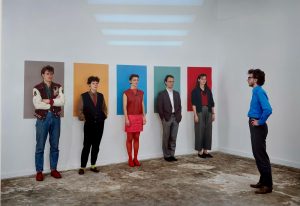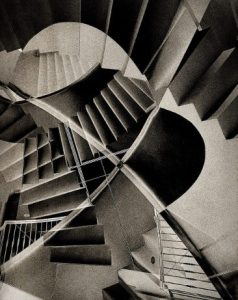קיקלון . את שם התערוכה צריך להגות. לחוש, כמעט לטעום, את הכאב והשיברון העולה ממנו.
***
תומר ספיר יצר מיצב הסובב סביב המילה “קיקלון”. המילה מופיעה בכתבי ביאליק פעמיים בלבד: בשיר “אבי” ובשיר “על סף בית המדרש”. כך החייה מילה המופיעה במקורות בספר הנביא חבקוק, (“תִסוב עָלֶיךָ כּוס ימין ה’ וקיקָלון על כּבודֶךָ “פרק ב, 16). המיצב מתייחס למילה כפי שהיא מופיעה ב”אבי”, שיר ממחזור שירי “יתמות” של ביאליק, המגולל את חיי אביו שמת כשהיה בן שש, כפי שנתפסו בעיניו. האב שהיה בעלים של בית מרזח (מקצוע אליו נדחקו יהודים מחוסר הזדמנויות תעסוקה אחרות) מתואר כמי שסבל מהסביבה הגסה בה עבד ונפשו יצאה לטוהר החיים הרוחניים. חייו במרחב הציבורי היו שונים בתכלית מחייו במרחב הביתי.

Bialik House Museum. The Second Floor.
Dr. Smadar Sheffi – Exhibition Curator
(photo Tom Porat)
יוֹם יוֹם – עֲלוֹת לְגַרְדֹּם, יוֹם יוֹם – הֻשְׁלֵךְ לְגֹב אֲרָיוֹת.
וּבְשׁוּבוֹ לְעֶת-עֶרֶב הַחֶדְרָה כֻּלּוֹ שׁוֹתֵת קִיקָלוֹן,
נִתְעָב וְנֶאֱלָח עַל נַפְשׁוֹ, כְּמָשׁוּי מִמְּצוּלַת סֶחִי,
שִׁוַּע לִבִּי לֶעֱנוּתוֹ, אֵלֶם יְגוֹנוֹ הִכְרִיעָנִי.
הקיקלון, מילה שהיא צרוף של “קיא” ו”קלון”, שמהדהד בה גם “כיליון” מקבלת בשיר הקשר של חומר אורגני, “שותת קיקלון” כמו שותת דם, הסחי והמיאוס כחומר פיזי.
***
כבר מעל עשור שתומר ספיר מתאפיין כאמן חוקר המתבונן במתודות מדעיות של קטלוג, השוואה ושימור ויוצר גוף עבודות בו פנטזיה ומציאות מתחככות ומאפשרות, תוך הרחקת עדות, לגעת בצפונות הנפש. ב ״מחקר לקראת האינדקס הקריפטו־טקסידרמי המלא״, הציע קטלוג, בלתי אפשרי של בעלי חיים שאינם נמצאים באינדקס הזואולוגי הרשמי וב״אם החיטה״ (אצרה טלי תמיר במוזיאון פתח תקוה), פיתח, בדיאלוג עם המחלקה לחקר הצמח במכון ויצמן, אופציות חדשות, דמיוניות לחיטה. במסגרת “אמנות בקומה השנייה בבית ביאליק” פרויקט אמנותי-מחקרי, העמיק ספיר בגוף העבודה של ביאליק וחקר בארכיון בעזרת שמואל אבנרי, מנהל הארכיב ומומחה ליצירת ביאליק.

Bialik House Museum. The Second Floor.
Dr. Smadar Sheffi – Exhibition Curator
(photo Tom Porat)
במיצב ספיר מתדיין עם המילה “קיקלון”, ונוגע במורכבות של יחסי טקסט – דימוי בכללם. הדימוי אינו איור לטקסט, אינו ממחיש אותו ואינו מתרגם אותו אך הוא מתייחס אליו, מקביל לו, לעיתים צומח מתוכו. מחד ספיר נצמד למקור הביאליקאי – אחת העבודות היא הגדלה של המילה בכתב ידו של ביאליק, ומאידך הוא מפקיע את “קיקלון” מההקשר ספציפי, מחבר אותה לרבדי אסוציאציות היסטוריות שונות ונוגע באינטנסיביות, במעיין הייאוש והזעם שהיא מביעה.
במרכז החלל הקטן, הרבוע, תלוי אובייקט א-מורפי העשוי שכבות נייר, מלט, מלח, גבס ופיגמנטים בצבע אדום זוהר וירוק מטאלי. אפשר לחשוב על עור שהופשט, או גווייה של חיה, במיוחד על הציור “שור שחוט” של רמברנדט מ-1655 (וציור המחווה של חיים סוטין לעבודה זו מ-1925). התחושה של חיים שנעלמו, של אובדן, נמצאת במרכז החלל כמו גוש בגרון הצופים.
העיסוק בגוף, בסופיותו וחולשתו, פותח את תיאורו של ביאליק את אביו:
נִגְלָה עָלַי רֹאשׁ אָבִי, גֻּלְגֹּלֶת קָדוֹשׁ מְעֻנֶּה,
כַּעֲרוּפָה מֵעַל כְּתֵפֶיהָ צָפָה בְעַנְנֵי עָשָׁן,
פָּנִים דָּוִים מִצַּעַר וְעֵינַיִם זֹלְגוֹת דָּם;
להתבוננות הבלתי מייפה, למודעות המלאה לשבריריות הקיום, יש הד במה שנראה כשרידי שלד, שבונה ספיר, על מראה המונחת על גבי שידה בצד החדר. התחושה הסטרילית שיוצרת המראה, הופכת את האובייקטים למרוחקים, אבל בתוכה – גם אנו הצופים הרכונים מעל האובייקטים – משתקפים והופכים לנוכחים בסביבה מורבידית.
לעומת האמורפיות של האובייקט הפיסולי, מציג ספיר את המילה בכתב היד של ביאליק כתובה על רקע כחול שמימי המתקבלת כעין הולוגרמה. השימוש בכתב היד, מתקשר לשימוש במונח באמנות חזותית, תחום שרבות מדובר בו, בהשאלה, על “כתב היד של האמן”. כאן משתמש ספיר קונקרטית בכתב היד של ביאליק ומטפורית מצטרף למסע בחוויה הטראומטית שמעבירה המילה “קיקלון”. אפשר לחשוב על כך גם כשכפול, או מחווה לפעולה הספרותית של ביאליק: ביאליק החייה מילה נשכחת וספיר מעיר אותה לחיים, מנכיח אותה במרחב ההווה. באותן צבעים עשוי גם דימוי נוסף של כיסא שבור באנדרלמוסיית חפצים -תמצות של קריסה.

Bialik House Museum. The Second Floor.
Dr. Smadar Sheffi – Exhibition Curator
האות קוף, בקליגרפיה מיוחדת לביאליק, מבודדת, זוהרת באדום חתוכה בשכבת פרספקס שחורה בוהקת. הפרספקס מוצמד לחלון והאות הטעונה – הנקראת כאות קין – תזהר בדומה לחלונות צבעוניים בכנסיות, ותחדיר אור שמהדהדות בו מיתולוגיות של כוח ולא סליחה. אות קין מאזכרת את הרגע המיתי בו קבלה האלימות פנים ושם. האות שהושם על קין כדי להגן עליו, הפך לסימן מובהק לקלונו, מקרה מובהק של נזילות בקריאת דימויים . בבחירת הצבעים מרמז לטוטליטריות פוליטית וכלכלית (אדום ושחור מקדמים שיווק של אין סוף מוצרים).
המבט הישיר של ביאליק הבוגר לילדותו בה התוודע לאופן בו היבטים קוטביים של נשגב וגס משתרגים – מפוכח ועגום.
מוּזָר הָיָה אֹרַח חַיַּי וּפְלִיאָה נְתִיבָתָם,
בֵּין שַׁעֲרֵי הַטָּהֳרָה וְהַטֻּמְאָה נָעוּ מַעְגְּלוֹתָם יָחַד,
הִתְפַּלֵּשׁ הַקֹּדֶשׁ בַּחֹל וְהַנִּשְׂגָּב בַּנִּתְעָב הִתְבּוֹסֵס.
ב” קיקלון ” מולך הצער, וכמו הילד שהיה ביאליק – נשתומם עליו.
ד”ר סמדר שפי
אוצרת התערוכה: דר’ סמדר שפי
אוצרת ראשית ומנהלת מתחם ביאליק : איילת ביתן שלונסקי
שיחה על התערוכה והקשריה למורשת ח.נ ביאליקי
בשיחה שתערך בספריתו של ביאליק ישתתפו שמואל אבנרי, ארכיון בית ביאליק, , האמן תומר ספיר ואוצרת התערוכה דר’ סמדר שפי . הקהל מוזמן לקחת חלק בשיחה.
יום שישי 3 במאי 2019 בשעה 11:30 .
הרשמה לניוזלטר הפרסומי השבועי של “החלון” בנושאי אמנות, אירועים ותערוכות חדשות www.smadarsheffi.com/?p=925 (הרישום נפרד מהרישום לבלוג)
סיור ספטמבר לביאנלה באיסטנבול – SOLD OUT
סיור אמנות ערב בתל – אביב סיור עומק עם דר’ סמדר שפי
יערך ביום רביעי, 22 מאי 2019 פרטים בקרוב .שילחו Whatsapp ל 0507431106 עם כתובת אימייל שלכן/ם להצטרפות לרשימת התפוצה.
עקבו אחרי באינסטגרם https://www.instagram.com/smadarsheffi/

Bialik House Museum. The Second Floor.
Dr. Smadar Sheffi – Exhibition Curator
Detail
Tomer Sapir – Kikalon
Bialik House Museum. The Second Floor.
The title of the exhibition must be articulated so as to almost taste the pain and heartache arising from it: Kikalon.
***
Tomer Sapir’s installation was inspired by the word kikalon. It appears twice in Bialik’s writings: in the poems “My Father,” and “On the Threshold of the House of Study.” Thus Bialik revived a word appearing only once in the Bible, in Habbakuk 2:16 (“The cup in the right hand of the Lord shall come around to you and disgrace upon your glory”). The installation refers to the word as it appears in the poem about Bialik’s father, part of the cycle “Orphanhood,” narrating the poet’s view of his father’s life, and his death when Bialik was six years old. The father, who owned a tavern (one of the professions available to Jews in Eastern Europe) suffered from the crude environment in which he worked, while yearning for a life of spirituality. Bialik’s father’s life in the public sphere was totally different from his life in the domestic sphere.
Day by day – going to the gallows – day by day thrown to the lions.
And when he returned at nightfall to the room all bleeding with shame,
debased, corrupted to his soul, like one dredged from the depths of filth,
my heart cried for his pain, the silent sorrow brought me to my knees.

Bialik House Museum. The Second Floor.
Dr. Smadar Sheffi – Exhibition Curator
(photo Tom Porat)
The word kikalon, a combination of ki – vomit, and kalon – disgrace, resonates also with the word khilion – annihilation. In the poem, Bialik places the word in a context of organic material. The image of “bleeding with shame” echoes the Hebrew word for blood oozing out of a wound, but here it refers to metaphorical disgust and filth.
***
For more than a decade, Tomer Sapir has been implementing scientific methodologies of taxonomy, cataloging, and preservation in his art, resulting in a corpus in which fantasy and reality meet. The friction between the two spheres makes it possible to touch upon the hidden layers of the soul. In his installation Research for the Full Crypto-Taxidermical Index he proposed an impossible catalog of creatures that are absent from the official zoological index. In Mother of All Wheat (Petach Tikva Museum of Art, Curator: Tali Tamir), Sapir developed new imaginary options for wheat in a dialog with the Weizmann Institute of Science Department of Plant Research. As part of the art research project, “Bialik House Museum. The Second Floor,” Sapir delved into Bialik’s oeuvre and conducted archival research with the assistance of Shmuel Avneri, Director of the Bialik Archive and expert on his writings.
Sapir’s installation conducts a dialog with the word kikalon, touching upon the complexity of the text-image relationship. The image does not illustrate the text, is not it concrete realization, nor its translation: the image refers to the text as a parallel, sometimes developing from the text. Sapir adheres to Bialik’s handwriting, enlarging the word kikalon as originally written, extracting the word from its specific context. He connects it to various associative historical layers, and a wellspring of rage and despair embodied in the word.
An amorphous object hangs at the center of the small square space on the Second Floor. It is made of layers of paper, cement, salt, plaster and fluorescent red and metallic green pigments. The object brings to mind flayed skin or an animal hide, especially Rembrandt’s Slaughtered Ox (1655) (and Chaim Soutine’s homage of 1925). The sensation of a life that disappeared, a feeling of loss, is located at the center of the space like a lump in one’s throat.
Bialik opens his description of his father with the engagement in the body, its finite nature and its weakness.
My father’s face appeared to me, his martyr’s skull tortured
as though lopped off his shoulders, floating in the clouds of smoke;
face twisted with sorrow and his eyes running blood;
His observation does not prettify existence, but is fully aware of the fragility of life, echoed in what looks like the remains of a skeleton that Sapir constructed on a mirror. The cold reflection transforms the objects into distant items and makes viewers present inside the morbid environment.
In contrast to the amorphous nature of the sculptural object, Sapir presents the word as written by Bialik’s own hand on a sky-blue background looking like a kind of hologram. The use of the handwriting alludes to “the artist’s handwriting,” a term used frequently in the visual arts. Here Sapir makes concrete use of Bialik’s actual and metaphorical handwriting, joining it to the trauma evoked by the word kikalon. We can think of it as a replication, or homage to Bialik’s literary activity. Bialik resuscitated a forgotten word and Sapir revives it, makes it present in the space of the present. The artist uses the same colors for an additional image of a broken chair in a confused heap of objects – the essence of collapse.
Bialik’s handwritten letter kof is isolated, shining in red, cut into a layer of glistening black Plexiglas installed in the window. The letter charged with meaning, said to be the Mark of Cain, is illuminated like colorful stained-glass church windows, penetrated by light resonating with mythologies of power – not forgiveness. The Mark of Cain reminds us of the primordial moment in which violence took on a face and a name. The mark placed on Cain to protect him became a sign of his disgrace (kalon), an obvious case of fluidity in the reading of images. The selection of colors hints at the territory of politics and economics (red and black promote the sale of numerous consumer goods).
The direct gaze of the adult Bialik at his childhood, during which he became aware of how the polarities of sublime and crude intertwine, is a sober and gloomy gaze.
My way of life was strange and its paths wondrous
among the gates of purity and baseness its trails led
at once sacred trod profane and the exalted rolled itself in dirt.
In Kikalon, the distress is at the forefront, and, like the young Bialik, we wonder at it.
Smadar Sheffi, PhD Curator
Ayelet Bitan Shlonsky – Chief Curator and Director of the Bialik Complex
הרשמה לניוזלטר הפרסומי השבועי של “החלון” בנושאי אמנות, אירועים ותערוכות חדשות www.smadarsheffi.com/?p=925 (הרישום נפרד מהרישום לבלוג)
סיור ספטמבר לביאנלה באיסטנבול – SOLD OUT
סיור אמנות ערב בתל – אביב סיור עומק עם דר’ סמדר שפי
יערך ביום רביעי, 22 מאי 2019 פרטים בקרוב .שילחו Whatsapp ל 0507431106 עם כתובת אימייל שלכן/ם להצטרפות לרשימת התפוצה.
עקבו אחרי באינסטגרם https://www.instagram.com/smadarsheffi/

Bialik House Museum. The Second Floor.
Dr. Smadar Sheffi – Exhibition Curator





